Regionalization of the Onset and Offset of the Rainy Season in Senegal Using Kohonen Self-Organizing Maps
Abstract
:1. Introduction
2. Materials and Methods
2.1. Materials
2.1.1. Geographical Information of Senegal
2.1.2. Satellites and Reanalyses
2.1.3. Daily Database for Senegal
2.2. Methods
2.2.1. Determining the Onset and Offset of the Rainy Season
2.2.2. Self-Organizing Maps Method
2.2.3. Hierarchical Ascendant Classification
3. Results and Discussion
3.1. Validation of CHIRPS Data Using Rain Gauge Data in Senegal
3.2. Spatial Variability of Onset and Cessation of the Rainy Season in Senegal
3.3. Spatial Variability of the Length of the Rainy Season in Senegal
3.4. Regionalization of the Onset and Offset in Senegal
4. Dynamic Analysis
4.1. Analysis of High-Altitude Fields
4.2. Analysis of Mid-Altitude Fields and Low-Altitude Fields
4.2.1. Analysis of Mid-Altitude Fields
4.2.2. Analysis of Low-Altitude Fields
5. Conclusions
Supplementary Materials
Author Contributions
Funding
Institutional Review Board Statement
Informed Consent Statement
Data Availability Statement
Acknowledgments
Conflicts of Interest
Abbreviations
| ITCZ | Intertropical Convergence Zone |
| CHIRPS | Climate Hazards Group Infrared Precipitation with Stations |
| OLR | outgoing longwave radiation |
| LRS | length of the rainy season |
| SOMs | self-organizing maps |
| HAC | hierarchical agglomerative clustering |
| MJO | Madden–Julian Oscillation |
| ENSO | El Niño Southern Oscillation |
| AEJ | African Easterly Jet |
| ITF | Intertropical Front |
| TEJ | Tropical Easterly Jet |
| MJJA | May, June, July, August |
| SON | September, Octobre, Novembe |
| CV | coefficient of variation |
| ICRISAT | International Crop Research Institute for the Semi-Arid Tropics |
| NHMS | National Hydrological and Meteorological Services |
References
- Toure, A.K.; Diakhaté, M.; Gaye, A.T.; Diop, M.; Ndiaye, O. Sensivity of Crop Yields to Temperature and Rainfall Daily Metrics in Senegal. Am. J. Rural. Dev. 2020, 8, 1–11. [Google Scholar]
- Touré, A.K.; Fall, C.M.N.; Diakhaté, M.; Wane, D.; Rodríguez-Fonseca, B.; Ndiaye, O.; Diop, M.; Gaye, A.T. Predictability of intra-seasonal descriptors of rainy season over Senegal using global SST patterns. Atmosphere 2022, 13, 1437. [Google Scholar] [CrossRef]
- FAO 2015 Country Fact Sheet on Food and Agriculture Policy Trends. Available online: https://www.fao.org/3/i4841e/i4841e.pdf (accessed on 10 February 2024).
- Fall, C.M.N.; Lavaysse, C.; Kerdiles, H.; Dramé, M.S.; Roudier, P.; Gaye, A.T. Performance of dry and wet spells combined with remote sensing indicators for crop yield prediction in Senegal. Clim. Risk Manag. 2021, 33, 100331. [Google Scholar] [CrossRef]
- Roudier, P.; Kane, C.; Leblois, A.; Sultan, B.; Weber, S. Deux Exemples de Stratégies de Gestion du Risque Agricole en Afrique de l’Ouest. Serv. Clim. Assur. Indicielles 2019, 239, 1–17. [Google Scholar]
- Diallo, I.; Giorgi, F.; Deme, A.; Tall, M.; Mariotti, L.; Gaye, A.T. Projected changes of summer monsoon extremes and hydroclimatic regimes over West Africa for the twenty-first century. Clim. Dyn. 2016, 47, 3931–3954. [Google Scholar] [CrossRef]
- Sultan, B.; Defrance, D.; Iizumi, T. Evidence of crop production losses in West Africa due to historical global warming in two crop models. Sci. Rep. 2019, 9, 12834. [Google Scholar] [CrossRef] [PubMed]
- Dieng, O.; Roucou, P.; Louvet, S. Variabilité intra-saisonnière des précipitations au Sénégal (1951–1996). Sécheresse 2008, 19, 87–93. [Google Scholar]
- Diba, I.; Camara, M. Analyse De L’impact Du Changement De La Couverture Végétale Sur La Pluie Et La Température De Surface Au Sénégal. Eur. Sci. J. 2017, 13, 29. [Google Scholar] [CrossRef]
- Sultan, B.; Roudier, P.; Quirion, P.; Alhassane, A.; Muller, B.; Dingkuhn, M.; Ciais, P.; Guimberteau, M.; Traore, S.; Baron, C. Assessing climate change impacts on sorghum and millet yields in the Sudanian and Sahelian savannas of West Africa. Environ. Res. Lett. 2013, 8, 014040. [Google Scholar] [CrossRef]
- Roudier, P.; Muller, B.; d’Aquino, P.; Roncoli, C.; Soumaré, M.A.; Batté, L.; Sultan, B. The role of climate forecasts in smallholder agriculture: Lessons from participatory research in two communities in Senegal. Clim. Risk Manag. 2014, 2, 42–55. [Google Scholar] [CrossRef]
- Sivakumar, M. Empirical analysis of dry spells for agricultural applications in West Africa. J. Clim. 1992, 5, 532–539. [Google Scholar] [CrossRef]
- Marteau, R.; Sultan, B.; Moron, V.; Baron, C.; Traoré, S.B.; Alhassane, A. The onset of the rainy season and farmers’ sowing strategy for pearl millet cultivation in Southwest Niger. Agric. For. Meteorol. 2011, 151, 1356–1369. [Google Scholar] [CrossRef]
- Mugalavai, E.M.; Kipkorir, E.C.; Raes, D.; Rao, M.S. Analysis of rainfall onset, cessation and length of growing season for western Kenya. Agric. For. Meteorol. 2008, 148, 1123–1135. [Google Scholar] [CrossRef]
- Camberlin, P. Les Précipitations dans la Corne Orientale de l’Afrique: Climatologie, Variabilité et Connexions Avec Quelques Indicateurs Océano-Atmosphériques. Ph.D. Thesis, Université de Bourgogne, Dijon, France, 1994. [Google Scholar]
- Fontaine, B.; Louvet, S.; Roucou, P. Definition and predictability of an OLR-based West African monsoon onset. Int. J. Climatol. J. R. Meteorol. Soc. 2008, 28, 1787–1798. [Google Scholar] [CrossRef]
- Sultan, B.; Janicot, S. Abrupt shift of the ITCZ over West Africa and intra-seasonal variability. Geophys. Res. Lett. 2000, 27, 3353–3356. [Google Scholar] [CrossRef]
- Balme, M.; Galle, S.; Lebel, T. Démarrage de la saison des pluies au Sahel: Variabilité aux échelles hydrologique et agronomique, analysée à partir des données EPSAT-Niger. Sci. Chang. Planétaires/Sécheresse 2005, 16, 15–22. [Google Scholar]
- Walter, M. Length of the rainy season in Nigeria. Niger. Geogr. J. 1967, 10, 123–128. [Google Scholar]
- Omotosho, J.B.; Balogun, A.; Ogunjobi, K. Predicting monthly and seasonal rainfall, onset and cessation of the rainy season in West Africa using only surface data. Int. J. Climatol. J. R. Meteorol. Soc. 2000, 20, 865–880. [Google Scholar] [CrossRef]
- Jolliffe, I.T.; Sarria-dodd, D.E. Early detection of the start of the wet season in tropical climates. Int. J. Climatol. 1994, 14, 71–76. [Google Scholar] [CrossRef]
- Marteau, R.; Moron, V.; Philippon, N. Spatial coherence of monsoon onset over western and central Sahel (1950–2000). J. Clim. 2009, 22, 1313–1324. [Google Scholar] [CrossRef]
- Sivakumar, M. Predicting rainy season potential from the onset of rains in Southern Sahelian and Sudanian climatic zones of West Africa. Agric. For. Meteorol. 1988, 42, 295–305. [Google Scholar] [CrossRef]
- Raes, D.; Sithole, A.; Makarau, A.; Milford, J. Evaluation of first planting dates recommended by criteria currently used in Zimbabwe. Agric. For. Meteorol. 2004, 125, 177–185. [Google Scholar] [CrossRef]
- Kipkorir, E.C.; Raes, D.; Bargerei, R.J.; Mugalavai, E.M. Evaluation of two risk assessment methods for sowing maize in Kenya. Agric. For. Meteorol. 2007, 144, 193–199. [Google Scholar] [CrossRef]
- Kohonen, T. The self-organizing map. Proc. IEEE 1990, 78, 1464–1480. [Google Scholar] [CrossRef]
- Gueye, A.K. Modélisation Statistique des Précipitations Quotidiennes au Sénégal. Ph.D. Thesis, Universite Pierre et Marie Curie, Paris, France, 2010. [Google Scholar]
- Lamb, P.J. Large-scale tropical Atlantic surface circulation patterns associated with Subsaharan weather anomalies. Tellus 1978, 30, 240–251. [Google Scholar] [CrossRef]
- Nicholson, S.E. Revised rainfall series for the West African subtropics. Mon. Weather. Rev. 1979, 107, 620–623. [Google Scholar] [CrossRef]
- Youssouph, S.; Geremy, P.; Ansoumana, B.; Theo, V.; Thierry, L.; Honore, D.; Guillaume, Q.; Catherine, W.; Ousmane, N.; Aida Diongue, N.; et al. Intensity–duration–frequency (IDF) rainfall curves in Senegal. Nat. Hazards Earth Syst. 2018, 18, 1849–1866. [Google Scholar] [CrossRef]
- Funk, C.C.; Peterson, P.J.; Landsfeld, M.F.; Pedreros, D.H.; Verdin, J.P.; Rowland, J.D.; Romero, B.E.; Husak, G.J.; Michaelsen, J.C.; Verdin, A.P.; et al. A quasi-global precipitation time series for drought monitoring. US Geol. Surv. Data Ser. 2014, 832, 1–12. [Google Scholar]
- Herold, N.; Behrangi, A.; Alexander, L.V. Large uncertainties in observed daily precipitation extremes over land. J. Geophys. Res. Atmos. 2017, 122, 668–681. [Google Scholar] [CrossRef]
- Sacré Regis, M.D.; Mouhamed, L.; Kouakou, K.; Adeline, B.; Arona, D.; Houebagnon Saint, J.C.; Koffi Claude, A.K.; Talnan Jean, H.C.; Salomon, O.; Issiaka, S. Using the CHIRPS dataset to investigate historical changes in precipitation extremes in West Africa. Climate 2020, 8, 84. [Google Scholar] [CrossRef]
- Xie, P.; Joyce, R.; Wu, S.; Yoo, S.H.; Yarosh, Y.; Sun, F.; Lin, R. Reprocessed, bias-corrected CMORPH global high-resolution precipitation estimates from 1998. J. Hydrometeorol. 2017, 18, 1617–1641. [Google Scholar] [CrossRef]
- Huffman, G.J.; Adler, R.F.; Bolvin, D.T.; Nelkin, E.J. The TRMM multi-satellite precipitation analysis (TMPA). In Satellite Rainfall Applications for Surface Hydrology; Springer: Berlin/Heidelberg, Germany, 2010; pp. 3–22. [Google Scholar]
- Sorooshian, S.; Nguyen, P.; Sellars, S.; Braithwaite, D.; AghaKouchak, A.; Hsu, K. Satellite-based remote sensing estimation of precipitation for early warning systems. Extrem. Nat. Hazards Disaster Risks Soc. Implic. 2014, 1, 99–112. [Google Scholar]
- Bichet, A.; Diedhiou, b.A. West African Sahel has become wetter during the last 30 years, but dry spells are shorter and more frequent. Clim. Res. 2018, 75, 155–162. [Google Scholar] [CrossRef]
- Bliefernicht, J.; Salack, S.; Waongo, M.; Annor, T.; Laux, P.; Kunstmann, H. Towards a historical precipitation database for West Africa: Overview, quality control and harmonization. Int. J. Climatol. 2022, 42, 4001–4023. [Google Scholar] [CrossRef]
- Frei, C.; Christensen, J.H.; Déqué, M.; Jacob, D.; Jones, R.G.; Vidale, P.L. Daily precipitation statistics in regional climate models: Evaluation and intercomparison for the European Alps. J. Geophys. Res. Atmos. 2003, 108. [Google Scholar] [CrossRef]
- Froidurot, S.; Diedhiou, A. Characteristics of wet and dry spells in the West African monsoon system. Atmos. Sci. Lett. 2017, 18, 125–131. [Google Scholar] [CrossRef]
- Davy, E.; Mattei, F.; Solomon, S. An Evaluation of Climate and Water Resources for Development of Agriculture in the Sudano-Sahelian Zone of West Africa; World Meteorological Organization: Geneva, Switzerland, 1976. [Google Scholar]
- Richardson, A.J.; Risien, C.; Shillington, F.A. Using self-organizing maps to identify patterns in satellite imagery. Prog. Oceanogr. 2003, 59, 223–239. [Google Scholar] [CrossRef]
- Lorenz, E.N. Empirical Orthogonal Functions and Statistical Weather Prediction; Massachusetts Institute of Technology, Department of Meteorology Cambridge: Cambridge, MA, USA, 1956; Volume 1. [Google Scholar]
- Badran, F.; Yacoub, M.; Thiria, S. Chapter 7: Self-organizing Maps and Unsupervised Classification. In Neural Networks, Methodology and Applications; Springer: Berlin/Heidelberg, Germany, 2005; pp. 379–442. [Google Scholar]
- Liu, Y.; Weisberg, R.H.; Mooers, C.N. Performance evaluation of the self-organizing map for feature extraction. J. Geophys. Res. Ocean. 2006, 111. [Google Scholar] [CrossRef]
- Riveros, N.A.M.; Espitia, B.A.C.; Pico, L.E.A. Comparison between K-means and self-organizing maps algorithms used for diagnosis spinal column patients. Inform. Med. Unlocked 2019, 16, 100206. [Google Scholar] [CrossRef]
- Kiang, M.Y.; Kumar, A. An evaluation of self-organizing map networks as a robust alternative to factor analysis in data mining applications. Inf. Syst. Res. 2001, 12, 177–194. [Google Scholar] [CrossRef]
- Liu, Y.; Weisberg, R.H. Patterns of ocean current variability on the West Florida Shelf using the self-organizing map. J. Geophys. Res. Oceans 2005, 110. [Google Scholar] [CrossRef]
- Murtagh, F.; Hernández-Pajares, M. The Kohonen self-organizing map method: An assessment. J. Classif. 1995, 12, 165–190. [Google Scholar] [CrossRef]
- Liu, Y.; Weisberg, R.H. A review of self-organizing map applications in meteorology and oceanography. Self-Organ. Maps Appl. Nov. Algorithm Des. 2011, 1, 253–272. [Google Scholar]
- Vesanto, J.; Alhoniemi, E. Clustering of the self-organizing map. IEEE Trans. Neural Netw. 2000, 11, 586–600. [Google Scholar] [CrossRef] [PubMed]
- Diatta, I. Impact des Fluctuations Pluviométriques sur la Production Agricole Dans la Région de Thionck-Essyl en Basse Casamance. Université Cheikh Anta Diop de Dakar-Certificat D’aptitude à L’enseignement Moyen (CAEM). 2007. Available online: https://www.memoireonline.com/07/08/1185/impact-fluctuations-pluviometriquesproduction-agricole-thionck-essyl.html (accessed on 10 February 2024).
- Badji, A.; Mohino, E.; Diakhat, É.M.; Juliette, M.; Amadou Thierno, G. Decadal Variability of Rainfall in Senegal: Beyond the total seasonal amount. J. Clim. 2022, 35, 5339–5358. [Google Scholar] [CrossRef]
- Sultan, B.; Janicot, S. The West African monsoon dynamics. Part II:. The “preonset” and “onset” of the summer monsoon. Journal of climate. J. Clim. 2003, 16, 3407–3427. [Google Scholar] [CrossRef]
- Camberlin, P.; Diop, M. Application of daily rainfall principal component analysis to the assessment of the rainy season characteristics in Senegal. Clim. Res. 2003, 23, 159–169. [Google Scholar] [CrossRef]
- Sane, T.; Mbaye, D.; Pascal, S. Rainy season quality study in Upper Casamance (South Senegal). Sci. Chang. Planétaires/Sécheresse 2008, 19, 23–28. [Google Scholar]
- Diop, M. A propos de la durée de la saison des pluies au Sénégal. Sci. Chang. Planétaires/Sécheresse 1996, 7, 7–15. [Google Scholar]
- Panthou, G.; Vischel, T.; Lebel, T. Recent trends in the regime of extreme rainfall in the Central Sahel. Int. J. Climatol. 2014, 34, 3998–4006. [Google Scholar] [CrossRef]
- Salack, S.; Giannini, A.; Diakhaté, M.; Gaye, A.T.; Muller, B. Oceanic influence on the sub-seasonal to interannual timing and frequency of extreme dry spells over the West African Sahel. Clim. Dyn. 2014, 42, 189–201. [Google Scholar] [CrossRef]
- Davies, D.L.; Bouldin, D.W. A cluster separation measure. IEEE Trans. Pattern Anal. Mach. Intell. 1979, PAMI-1, 224–227. [Google Scholar] [CrossRef]
- Duchon, C.E. Lanczos filtering in one and two dimensions. J. Appl. Meteorol. Climatol. 1979, 18, 1016–1022. [Google Scholar] [CrossRef]
- Besson, L. Processus Physiques Responsables de l’Etablissement et de la Variabilité de la Mousson Africaine. Ph.D. Thesis, Université Pierre et Marie Curie-Paris VI, Paris, France, 2009. [Google Scholar]
- Sultan, B. Etude de la mise en place de la mousson en Afrique de l’Ouest et de la variabilité intra—Saisonnière de la convection. Application à la sensibilité des rendements agricoles. Ph.D. Thesis, Université Paris, Paris, France, 2002. [Google Scholar]
- Lafore, J.P.; Asencio, N.; Bouniol, D.; Flamant, C.; Guichard, F.; Hall, N.; Janicot, S.; Kocha, C.; Lavaysse, C.; Leroux, S.; et al. Évolution de notre compréhension du système de mousson ouest-africain. La Météorologie 2012, 11–16. [Google Scholar] [CrossRef]
- Cook, K.H. Generation of the African easterly jet and its role in determining West African precipitation. J. Clim. 1999, 12, 1165–1184. [Google Scholar] [CrossRef]
- Saley, I.A.; Sanda, S.I.; Bell, J.P.; Ly, M.; Salack, S.; Fode, M.; Diedhiou, A. Impacts potentiels de la Grande Muraille Verte sur le climat du Sahel et de l’Afrique de l’Ouest. Ann. l’Université Abdou Moumouni 2016, 1, 1–18. [Google Scholar]
- Nicholson, S.E.; Grist, J. A conceptual model for understanding rainfall variability in the West African Sahel on interannual and interdecadal timescales. Int. J. Climatol. J. R. Meteorol. Soc. 2001, 21, 1733–1757. [Google Scholar] [CrossRef]
- Newell, R.E.; Kidson, J.W. African mean wind changes between Sahelian wet and dry periods. J. Climatol. 1984, 4, 27–33. [Google Scholar] [CrossRef]
- Hagos, S.M.; Cook, K.H. Ocean warming and late-twentieth-century Sahel drought and recovery. J. Clim. 2008, 21, 3797–3814. [Google Scholar] [CrossRef]
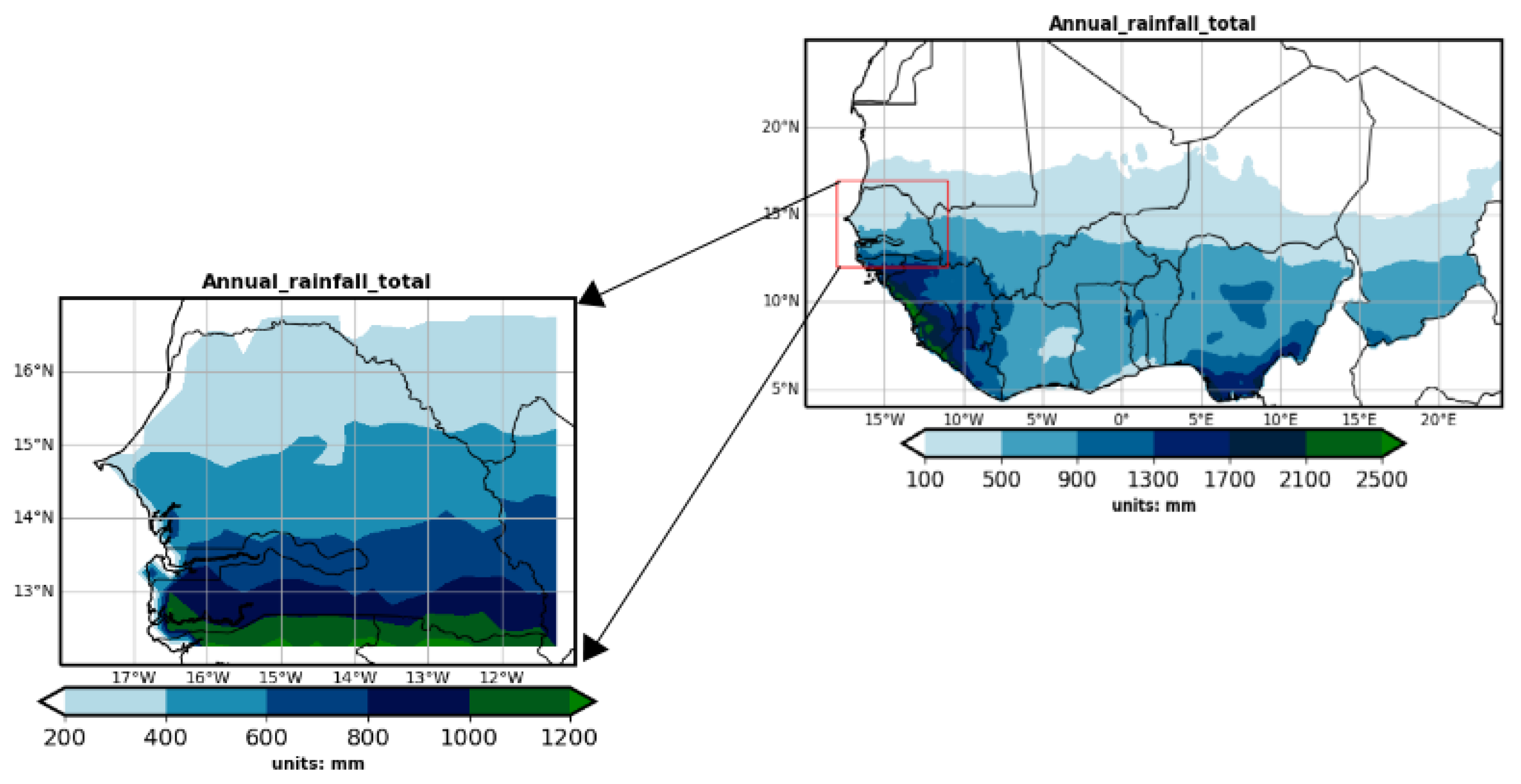
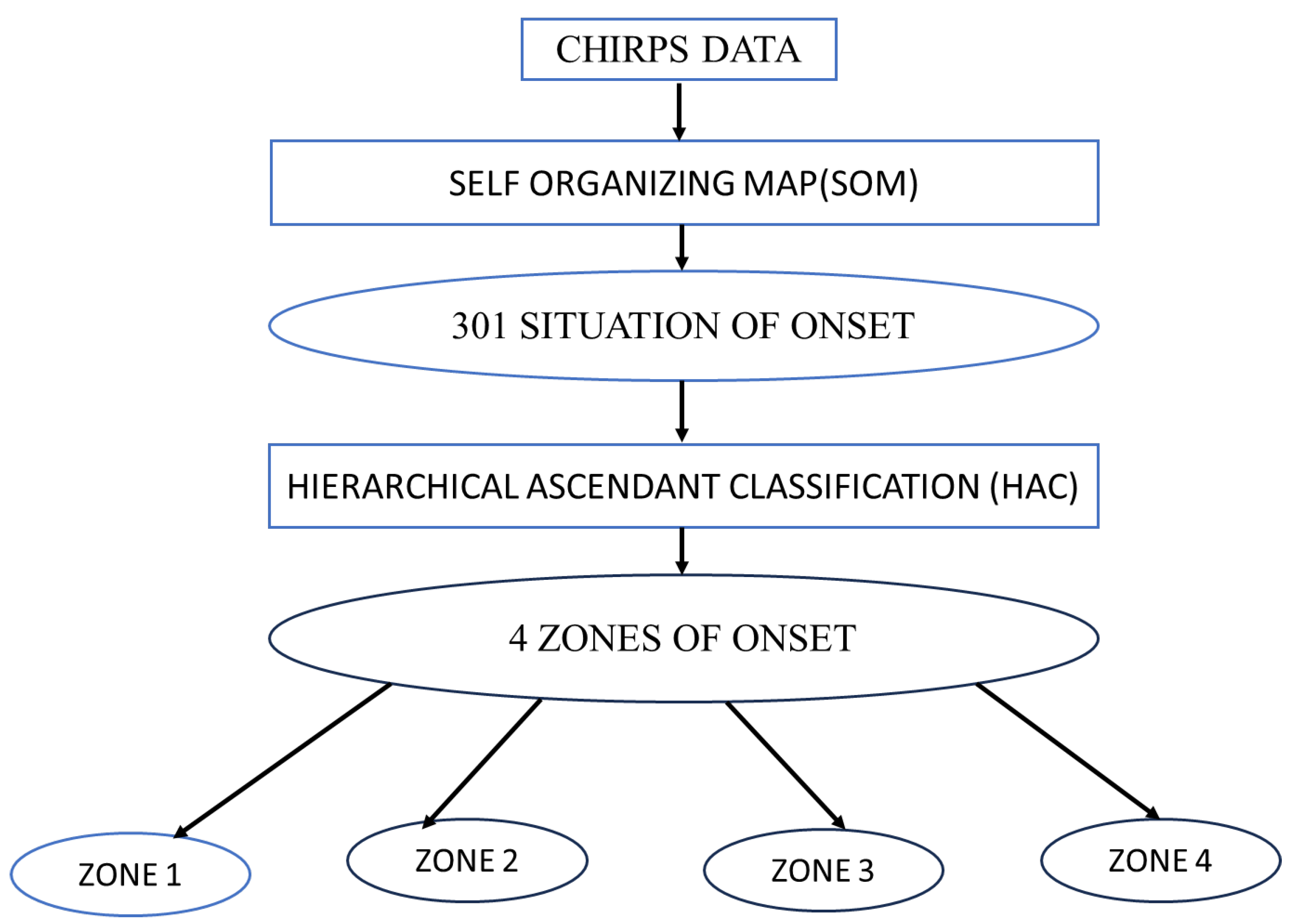

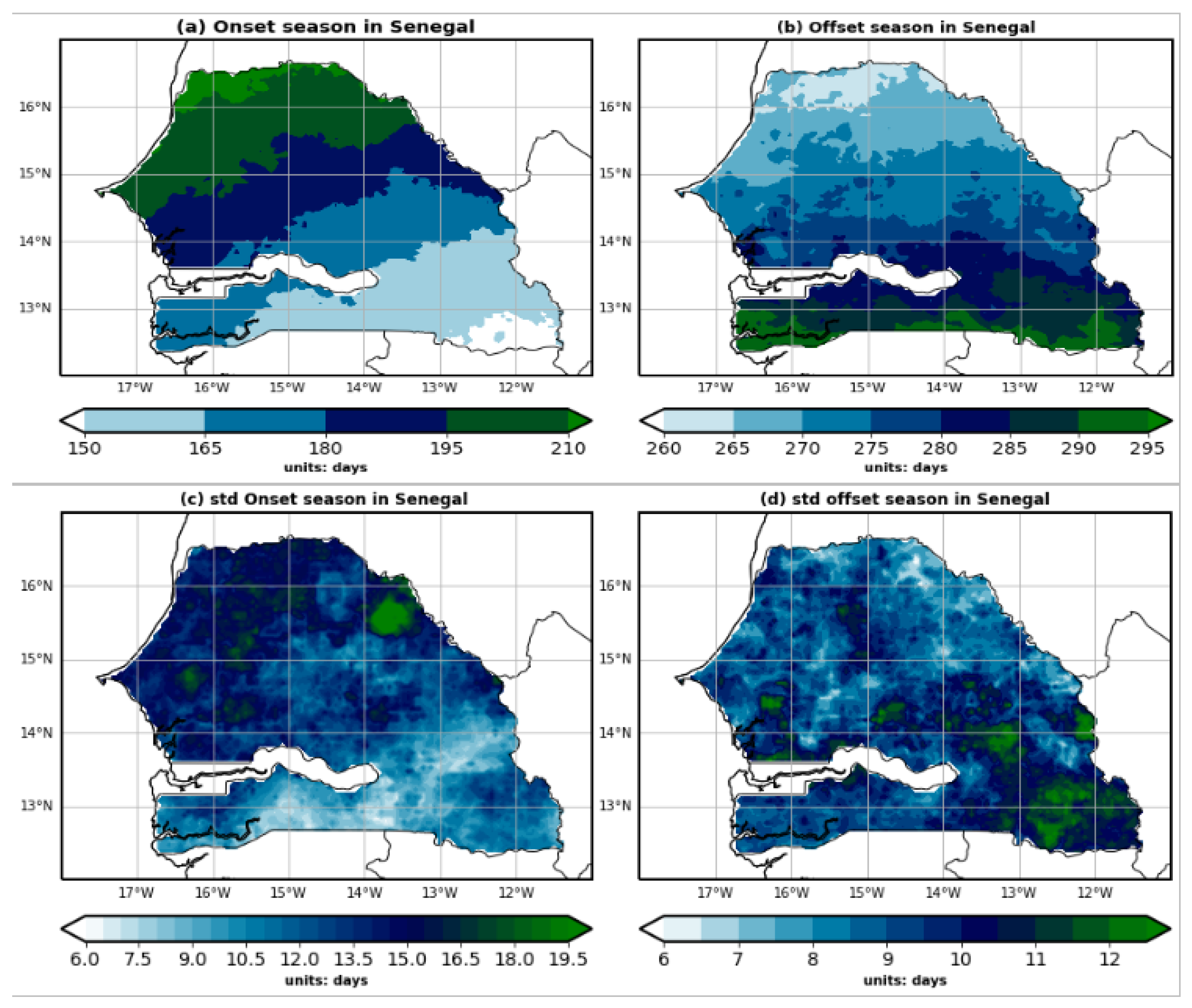

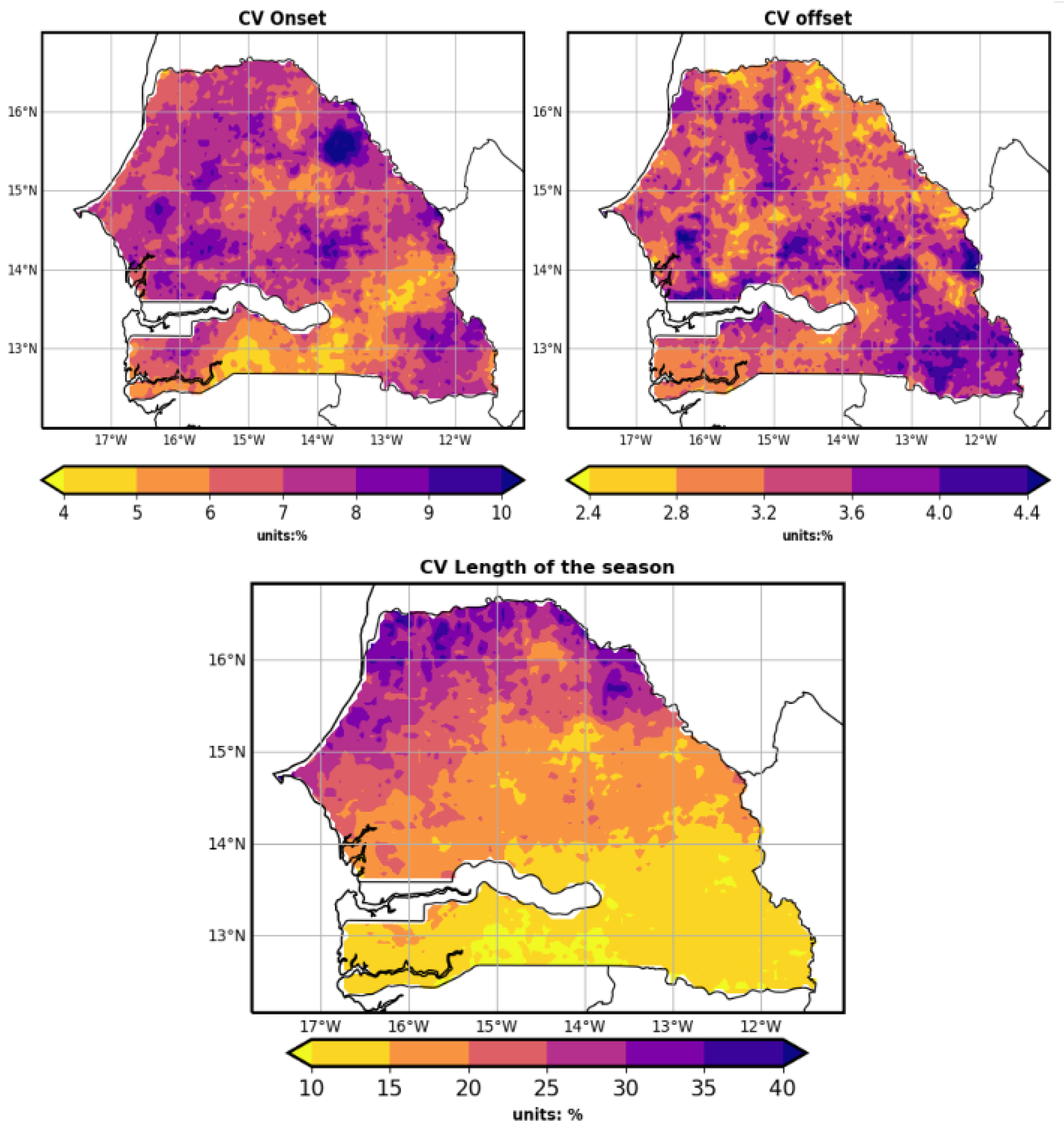


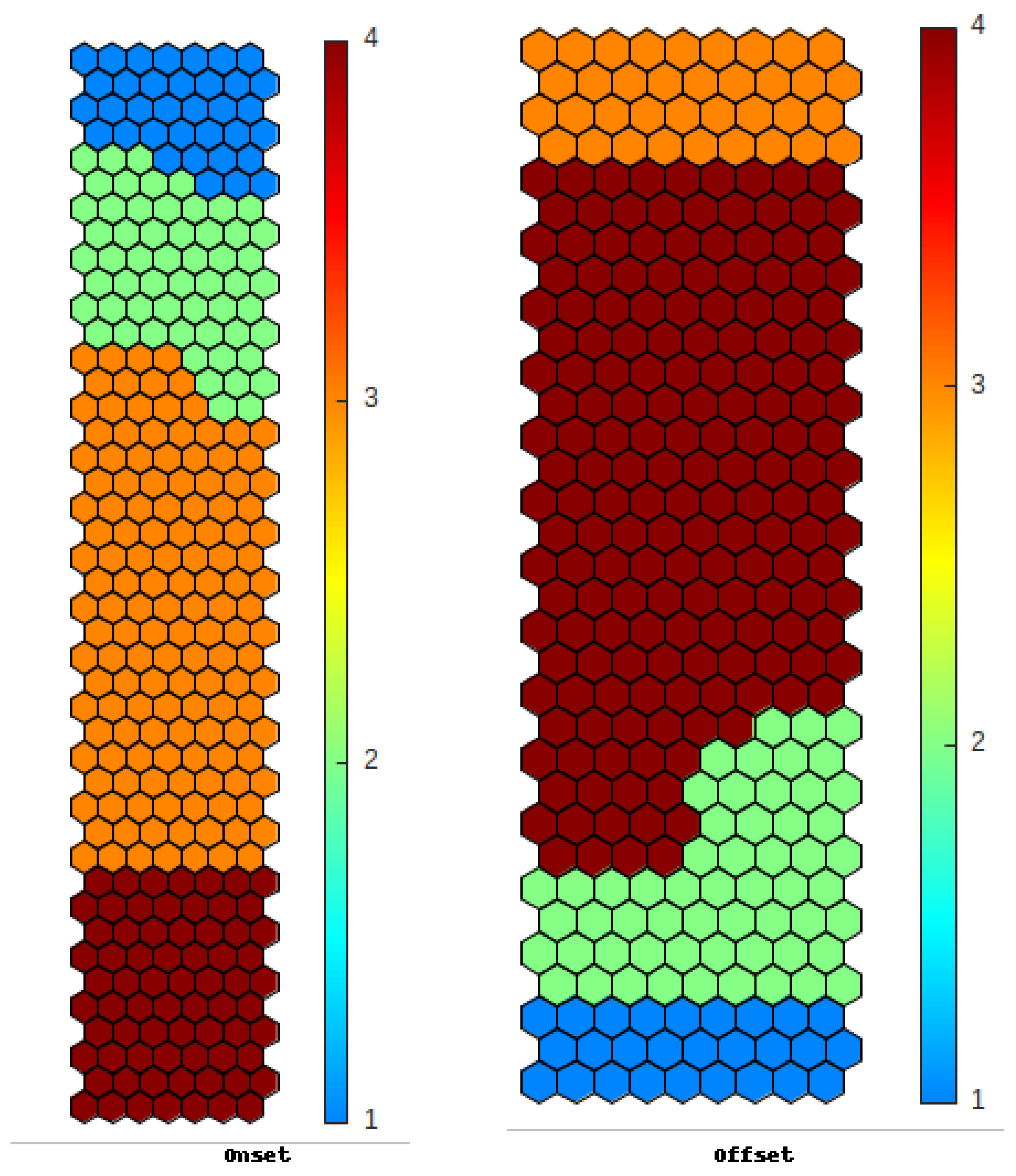

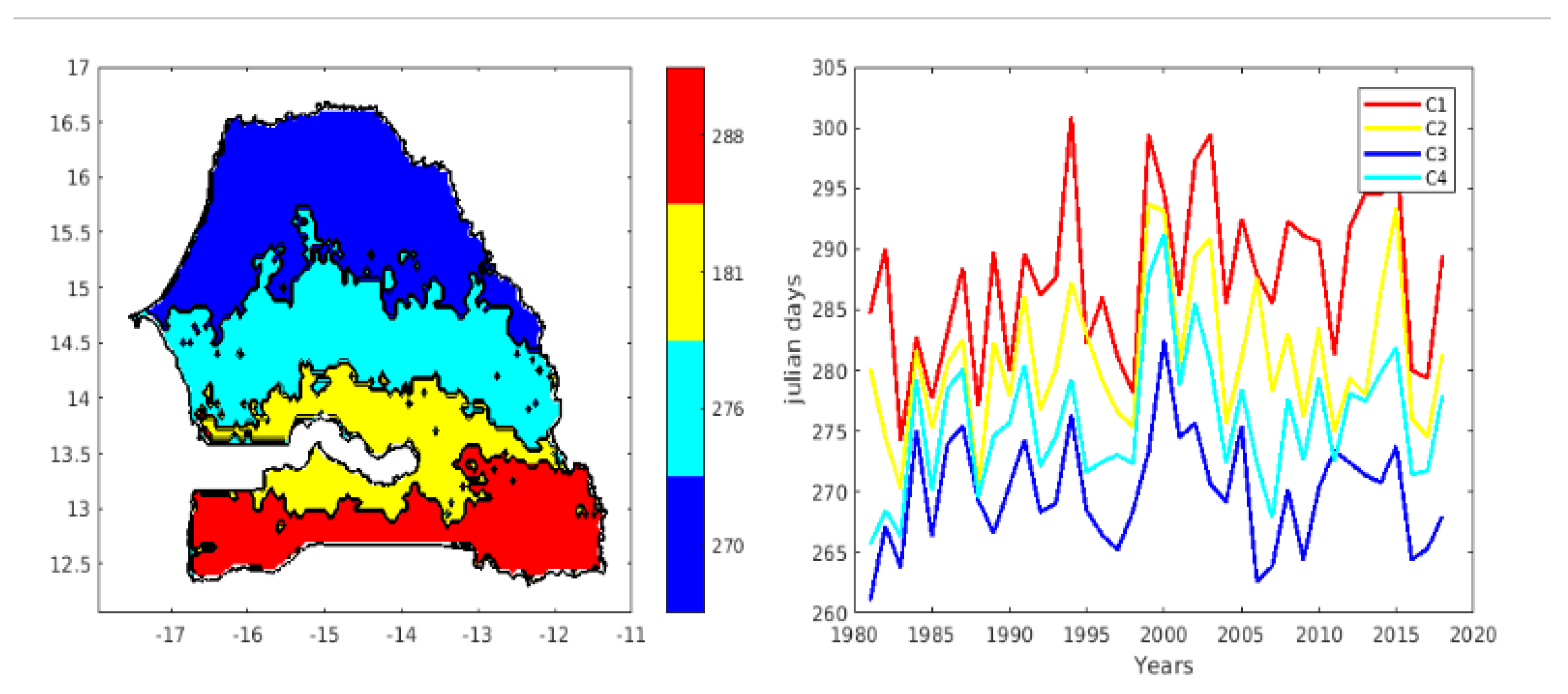

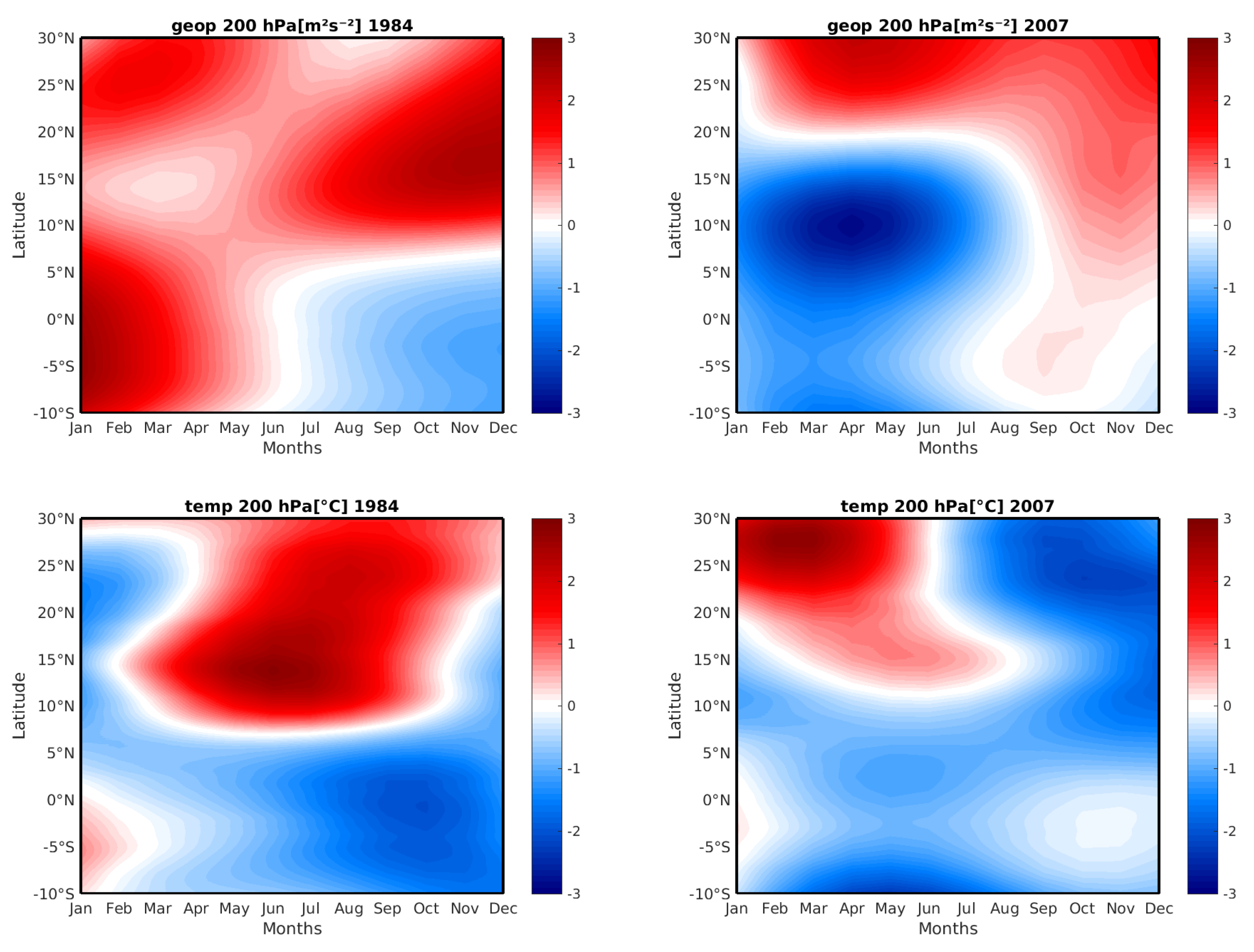

Disclaimer/Publisher’s Note: The statements, opinions and data contained in all publications are solely those of the individual author(s) and contributor(s) and not of MDPI and/or the editor(s). MDPI and/or the editor(s) disclaim responsibility for any injury to people or property resulting from any ideas, methods, instructions or products referred to in the content. |
© 2024 by the authors. Licensee MDPI, Basel, Switzerland. This article is an open access article distributed under the terms and conditions of the Creative Commons Attribution (CC BY) license (https://creativecommons.org/licenses/by/4.0/).
Share and Cite
Faye, D.; Kaly, F.; Dieng, A.L.; Wane, D.; Fall, C.M.N.; Mignot, J.; Gaye, A.T. Regionalization of the Onset and Offset of the Rainy Season in Senegal Using Kohonen Self-Organizing Maps. Atmosphere 2024, 15, 378. https://doi.org/10.3390/atmos15030378
Faye D, Kaly F, Dieng AL, Wane D, Fall CMN, Mignot J, Gaye AT. Regionalization of the Onset and Offset of the Rainy Season in Senegal Using Kohonen Self-Organizing Maps. Atmosphere. 2024; 15(3):378. https://doi.org/10.3390/atmos15030378
Chicago/Turabian StyleFaye, Dioumacor, François Kaly, Abdou Lahat Dieng, Dahirou Wane, Cheikh Modou Noreyni Fall, Juliette Mignot, and Amadou Thierno Gaye. 2024. "Regionalization of the Onset and Offset of the Rainy Season in Senegal Using Kohonen Self-Organizing Maps" Atmosphere 15, no. 3: 378. https://doi.org/10.3390/atmos15030378




